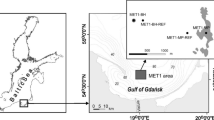Abstract
The occurrence of pyrite (FeS2) and iron sulfide in surficial sediments of Piburger See was compared with thermodynamic calculations based on chemical analyses of iron and hydrogen sulfide in the interstitial water. The area below 17 m, where black spots were found in the sediments, showed ion products (log KFeS=aFe2·aHS/aH+) between−3.11 and −4.01. In areas with no visible FeS concretions logKFeS values were in the range of −4.74 to −5.77, thus thermodynamic calculations seem to be in accordance with the appearance of iron sulfide. Nevertheless pyrite framboids, composed by more than 1,000 single crystals, coul be found even in shallow parts of the lake. Therefore the formation of pyrite is assumed to occur in microniches (diatom frustules, testacean shells). Inside these microcompartments high concentrations of hydrogen sulfide are reached due to the anaerobic decomposition of organic matter, whereas iron and additional sulfur are supplied by the diffusion of ferrous iron and sulfate from the anoxic environment.
Similar content being viewed by others
Literaturverzeichnis
Barton, P.B., und Skinner, B.J.: Sulfide mineral stabilities. In: Barnes, H.L. (Ed.): Geochemistry of hydrothermal ore deposits, Wiley & Sons, N.Y. 1979.
Berner, R.A.: Thermodynamic stability of sediment iron sulfides. Am. J. Sci.265, 773–785 (1967).
Berner, R.A.: Principles of chemical sedimentology, McGraw-Hill, N.Y. 1971.
Berner, R.A.: Early diagenesis. A theoretical approach, Princeton University Press, Princeton, N.J. 1980.
Bürgi, H.R.: Die Wirkung von NTA auf das Wachstum des Phytoplanktons unter besonderer Berücksichtigung des Eisens als Mikroelement. Schweiz. Z. Hydrol.36, 1–71 (1974).
Clyne, J.D.: Spectrophotometric determination of hydrogen sulfide in natural waters. Limnol. Oceanogr.14, 454–458 (1969).
Davison, W.: Soluble inorganic ferrous complexes in natural waters. Geochim. cosmochim. Acta43, 1693–1696 (1979).
Davison, W.: A critical comparison of the measured solubilities of ferrous sulfide in natural waters. Geochim. cosmochim. Acta44, 803–808 (1980).
Davison, W., und Heaney, S.I.: Ferrous iron-sulfide interactions in anoxic hypolimnetic waters. Limnol. Oceanogr.23, 1194–1200 (1978).
Davison, W., und Heaney, S.I.: Determination of the solubility of ferrous sulfide in a seasonally anoxic marine basin. Limnol. Oceanogr.25, 153–156 (1980).
Ganthaler, O.: Elsenkreislauf und Eisenbakterien im Pelagia des Piburger-Sees (Ötztal, Tirol). Diss. Abt. Limnol. Innsbruck6, 1–167 (1977).
Garrels, R.M., und Christ, C.L.: Solutions, minerals and equilibria, Freeman, Cooper & Comp., San Francisco 1965.
Helgeson, H.C.: Thermodynamics of hydrothermal systems at elevated temperatures and pressures. Am. J. Sci.267, 729–804 (1969).
Helgeson, H.C.: Program SUPCRT. Pric. comm. (1978).
Helgeson, H.C., Delany, H.W., Nesbitt, H.W., und Bird, D.K.: Summary and critique of the thermodynamic properties of rock forming minerals. Am. J. Sci.278(A), 1–229 (1978).
Jørgensen, B.B.: Bacterial sulfate reduction within reduced microniches of oxidized marine sediments. Marine Biol.14, 7–17 (1977).
Ladurner, J., und Schulz, O.: Der ehemalige Bergbau von Haderlehn (Ötztal). Veröff. Mus. Ferdinandeum Innsbr.49, 101–108 (1969).
Lindström, C.H.M., und Bågander, L.E.: In situ determination of the solubility product for freshly precipitated FeS(amorph)). Contrib. Microbial Geochem. Dept. Geol. Univ. Stockholm4 (1980).
Pechlaner, R.: Die Restaurierung des Piburger Sees. Sonderh. Carinthia II (Festschrift Findenegg)41, 97–115 (1971).
Pechlaner, R.: Response of the eutrophied Piburger See to reduced external loading and removal of monilimnic water. Arch. Hydrobiol. Beih. Ergebn. Limnol.13, 293–305 (1979).
Psenner, R., Pechlaner, R., und Rott, E.: Ergebnisse des MAB-5-Projektes «Belastung und Belastbarkeit des Piburger Sees». Man and Biosphere, Project 5, Wien 1983 (im Druck).
Pyzik, A.J.: The kinetics and mechanisms of sedimentary iron sulfide formation, S. 1–144. Ph.D. Univ. Maryland (1976).
Tessenow, U.: Lösungs-, Diffusions- und Sorptionsprozesse in der Oberschicht von Seesedimenten. IV. Reaktionsmechanismen und Gleichgewichte im System Eisen-Mangan-Phosphat im Hinblick auf die Vivianit-Akkumulation im Ursee. Arch. Hydrobiol., Suppl.47 (Falkau-Arbeiten 9), 1–79 (1974).
Tipping, E., Woof, C., und Cooke, D.: Iron oxides from a seasonally anoxic lake. Geochim. cosmochim. Acta45, 1411–1419 (1981).
Vogler, P.: Zur Analytik kondensierter Phosphate und organischer Phosphate bei limnologischen Untersuchungen. Int. Revue ges. Hydrobiol.51, 775–785 (1966).
Volkov, I.I.: Iron sulfides, their interdependence and transformation in the Black Sea bottom sediments. Akad. Nauk SSSR, Inst. Okeanologii Trudy50, 68–92 (1961).
Wagner, G.: FeS-Konkretionen im Bodensee. Int. Revue ges. Hydrobiol.56, 265–272 (1971).
Walther, J.W., und Helgeson, H.C.: Calculation of the thermodynamic properties of aqueous silica and the solubility of quartz and its polymorphs at high pressures and temperatures. Am. J. Sci.277, 1315–1351 (1977).
Author information
Authors and Affiliations
Rights and permissions
About this article
Cite this article
Psenner, R. Die Entstehung von Pyrit in rezenten Sedimenten des Piburger Sees. Schweiz. Z. Hydrologie 45, 219–232 (1983). https://doi.org/10.1007/BF02538157
Received:
Issue Date:
DOI: https://doi.org/10.1007/BF02538157




